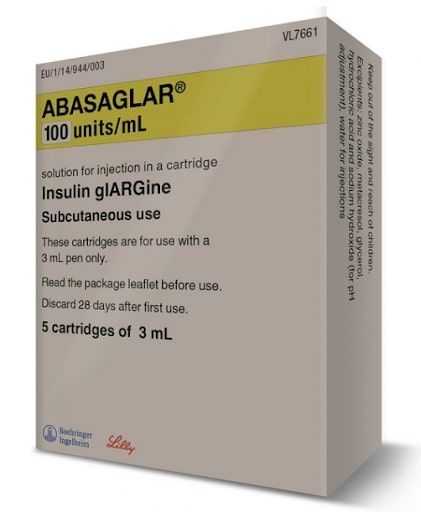
Type:3ml Cartidge
Generic Name:Insulin Glargine
Manufacturer:Eli Lilly and Company
Price:৳895.00
Diabetes mellitus
Administer subcutaneously in the upper arm, thigh or abdominal wall. A subcutaneous injection into the abdominal wall results in a faster absorption than from other injection sites. Should not be administered IV or via an insulin pump; IV administration of the usual SC dose could result in severe hypoglycemia
Subcutaneous Type 1 or 2 Diabetes Mellitus Initial dose Type 1 diabetes mellitus: Starting dose should be approximately one third of the total daily insulin requirements; short-acting, premeal insulin should be used to satisfy the remaining two thirds of the daily insulin requirements; insulin glargine should be used in combination with a short-acting or rapid-acting insulin; Type 2 diabetes mellitus: Starting dose in patients who are not currently treated with insulin is 10 units (or 0.2 unit/kg) once daily Dosage should be individualized in accordance with the needs of the patient and adjusted according to blood glucose measurement Converting from other insulins If changing from a treatment regimen with an intermediate- or long-acting insulin to a regimen with insulin glargine, the amount and timing of shorter-acting insulins and doses of any oral antidiabetic drugs may need to be adjusted From once-daily NPH insulin to once-daily insulin glargine: Initial dose is the same as the dose of NPH that is being discontinued From twice-daily NPH insulin to once-daily insulin glargine: Initial dose is 80% of the total daily NPH dose that is being discontinued; this dose reduction will lower the likelihood of hypoglycemia Dosing Considerations Indicated for once-daily SC administration; exhibits relatively constant glucose-lowering profile over 24 hr May be administered at any time during the day; should be administered SC once daily at the same time every day Dose must be individualized based on clinical response; blood glucose monitoring is essential in all patients receiving insulin therapy In patients with type 1 diabetes, insulin glargine must be used in regimens with short-acting insulin As with all insulins, injection sites should be rotated within the same region (abdomen, thigh, or deltoid) from one injection to the next to reduce the risk of lipodystrophy; no clinically relevant difference in insulin glargine absorption after abdominal, deltoid, or thigh SC administration As with all insulins, the rate of absorption and, consequently, the onset and duration of action may be affected by exercise and other variables (eg, stress, intercurrent illness, changes in coadministered drugs, meal patterns)
Type 1 Diabetes Mellitus It is a long-acting human insulin analogue indicated to improve glycemic control in children with type 1 diabetes mellitus; <6 years: Safety and efficacy not established >6 years: Approximately one third of the total daily insulin requirements SC; rapid-acting or short-acting, premeal insulin should be used to satisfy the remaining two thirds of the daily insulin requirements; usual daily maintenance range in adolescents is <1.2 units/kg/day during growth spurts
Renal impairment: Dose adjustments may be needed.
Hypoglycaemia; IV route.
Insulin glargine, a long-acting analog of human insulin, regulates carbohydrate, protein and fat metabolism by inhibiting hepatic glucose production and lipolysis, and enhancing peripheral glucose disposal.
Renal or hepatic impairment; pregnancy; lactation; child <6 yrs. Transferring from other insulin. Monitor serum glucose, potassium, electrolytes, HbA1c and lipid profile. Concomitant illness esp infections; hypokalaemia. Lactation: Considered safe for use while breast feeding
Hypoglycaemia, lipodystrophy, pruritus, rash, wt gain, sodium retention and oedema. Inj site reactions e.g. pain, itching, hives, swelling and inflammation. Influenza-like symptoms, Pallor, Palpitation, Tachycardia, Mental confusion, Weakness, Blurred vision, Itching, Hunger, Nausea.
Effects may be increased by: oral antidiabetic agents, ACE inhibitors, disopyramide, fibrates, fluoxetine, MAOIs, propoxyphene, salicylates, somatostatin analog (e.g. octreotide), sulfonamide antibiotics. Effects may be decreased by: corticosteroids, niacin, danazol, diuretics, sympathomimetic agents, isoniazid, phenothiazine derivatives, somatropin, thyroid hormones, oral contraceptives, lithium. Signs of hypoglycaemia may be masked by beta-blockers, clonidine.